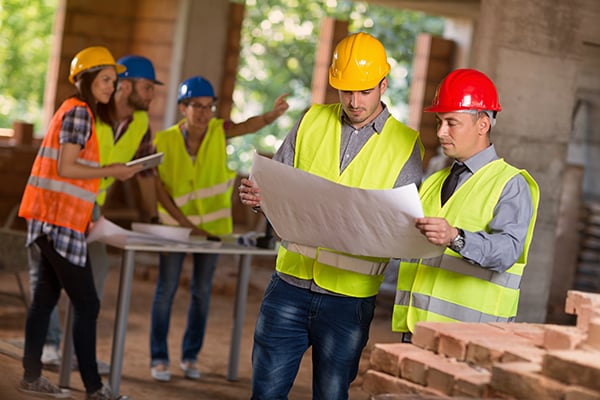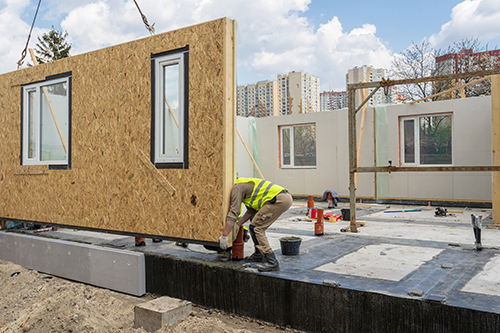By Libby Dunne
Sustainability Analyst
Sustainable Investment Group (SIG)
 Charlie Cichetti, SIG co-founder and CEO, recently gave a webinar focused on 10 ways to green up your construction site. In this webinar, Cichetti discussed the importance of transforming some green building operational practices onto the construction jobsite in order to reduce the carbon footprint of building construction. Through a LEED Building Design and Construction (BD+C) lens, Cichetti focuses on how sustainable materials and ideas that are being put into a building can also be implemented on the construction site. Here is a countdown of Cichetti’s list for how to do this:
Charlie Cichetti, SIG co-founder and CEO, recently gave a webinar focused on 10 ways to green up your construction site. In this webinar, Cichetti discussed the importance of transforming some green building operational practices onto the construction jobsite in order to reduce the carbon footprint of building construction. Through a LEED Building Design and Construction (BD+C) lens, Cichetti focuses on how sustainable materials and ideas that are being put into a building can also be implemented on the construction site. Here is a countdown of Cichetti’s list for how to do this:
- Green Team and better onsite communication: Some projects have a green team of project volunteers that are passionate about sustainability. Do this in all projects! Creating a green team of contractors, subcontractors, and stakeholders can help to involve all members of a project team in green goals and ideas. Especially for projects pursuing a LEED BD+C certification, creating this green team can get more buy-in among the team, and help people recognize how they can help to pursue these goals. Using Turner Construction as an example, their green team helped to create a checklist of waste tracking and best practices, ensured recycling containers were placed in trailers on the job site, and updated whiteboards detailing their green construction efforts each week. The creation of a team like this can help get the whole construction team on board with green practices throughout the project timeline.
-
 Ridesharing/no idling/preferred parking: We know that many parking garages and parking lots offer preferred parking for electric vehicles, or that HOV lanes reward drivers who carpool, but why not use these same incentives for employees traveling to a job site? Providing people who participate in these alternative transportation methods with closer and more accessible parking spaces can help to reduce carbon emissions by cutting down on transportation-related emissions on the job site.
Ridesharing/no idling/preferred parking: We know that many parking garages and parking lots offer preferred parking for electric vehicles, or that HOV lanes reward drivers who carpool, but why not use these same incentives for employees traveling to a job site? Providing people who participate in these alternative transportation methods with closer and more accessible parking spaces can help to reduce carbon emissions by cutting down on transportation-related emissions on the job site.
-
 LEED Credentials for the onsite team: For many LEED BD+C projects, there is only one member of the construction team who has a LEED accreditation, or even just who understands the LEED goals and responsibilities. Having more members of the construction team that understand these goals can be very beneficial for communication, idea sharing, and can help increase the incentive to participate in green practices at the jobsite. Contractors can offer onsite LEED trainings to help increase transparency about some plans for the project and can also provide training and help to incentivize members of the team to get their LEED credentials as well. Another benefit of having more individuals with LEED training is that their expertise carries over between projects. This one-time investment can help to ensure a more sustainability-focused team for current as well as future projects.
LEED Credentials for the onsite team: For many LEED BD+C projects, there is only one member of the construction team who has a LEED accreditation, or even just who understands the LEED goals and responsibilities. Having more members of the construction team that understand these goals can be very beneficial for communication, idea sharing, and can help increase the incentive to participate in green practices at the jobsite. Contractors can offer onsite LEED trainings to help increase transparency about some plans for the project and can also provide training and help to incentivize members of the team to get their LEED credentials as well. Another benefit of having more individuals with LEED training is that their expertise carries over between projects. This one-time investment can help to ensure a more sustainability-focused team for current as well as future projects.
-
 Green materials: This one may seem like an obvious point but using green materials for both permanent and temporary structures at a jobsite is necessary for creating a green building. Cichetti explains that it is important to think beyond just doing enough to earn LEED credits when choosing green materials: go above and beyond on finding cost-effective yet rapidly renewable materials, chose recycled materials over items without recycled content, even focus on green materials for temporary materials used during construction. For additional incentive, a project can also earn innovation points towards their LEED certification for using green materials for temporary items.
Green materials: This one may seem like an obvious point but using green materials for both permanent and temporary structures at a jobsite is necessary for creating a green building. Cichetti explains that it is important to think beyond just doing enough to earn LEED credits when choosing green materials: go above and beyond on finding cost-effective yet rapidly renewable materials, chose recycled materials over items without recycled content, even focus on green materials for temporary materials used during construction. For additional incentive, a project can also earn innovation points towards their LEED certification for using green materials for temporary items.
-
 Prefabricated construction materials: Using prefabricated or preassembled pieces in a project can help green up a construction project. Many times, a project will bring in a surplus of materials in order to ensure it has enough. Using prefabricated materials can reduce this waste because the piece is delivered whole, preventing the need for having extra resources. Additionally, using preassembled pieces can also reduce carbon emissions by only requiring one shipment instead of many smaller deliveries of materials. Using these prefabricated pieces can even be more cost-effective. Potentially most important, using these prefabricated materials instead of assembling pieces onsite can potentially reduce the risk of injury and ensure the safety of people working at the jobsite.
Prefabricated construction materials: Using prefabricated or preassembled pieces in a project can help green up a construction project. Many times, a project will bring in a surplus of materials in order to ensure it has enough. Using prefabricated materials can reduce this waste because the piece is delivered whole, preventing the need for having extra resources. Additionally, using preassembled pieces can also reduce carbon emissions by only requiring one shipment instead of many smaller deliveries of materials. Using these prefabricated pieces can even be more cost-effective. Potentially most important, using these prefabricated materials instead of assembling pieces onsite can potentially reduce the risk of injury and ensure the safety of people working at the jobsite.
- Jobsite best practices: Following jobsite best practices can also help to green up a construction site. Using LED temporary lighting for example can reduce the amount of electricity used on a project. Additionally, LED temporary lighting can be transferred from project to project to reduce costs on both current and future projects. Furthermore, putting timers or sensors on the lights can increase these cost and sustainability benefits. Other jobsite best practices for creating a greener construction site can include providing reusable water bottles to the team, having compostable containers/plates/utensils as well as a compost bin, creating and growing a garden for projects with long timelines, and improving signage for dumpsters and sorting materials. These are all examples of simple and cost-effective changes that a green team can implement to greatly reduce the carbon footprint of a construction site.
- Virtual meetings, and data/video share: The current COVID-19 outbreak has forced many to work from home and communicate through video conferencing platforms. Keeping up with these virtual meetings even after returning to work can help reduce carbon emissions by cutting down on travel. Of course, some site visits will be essential, but for those that aren’t, virtual meetings can help to reduce carbon emissions as well as cut down on time while still sharing information. Video conferencing can even be used to look at equipment or data as a team without everyone having to travel to the project site.
- Utility tracking: Tracking utility consumption for a construction site is vital for knowing where major cost sinks and carbon sources are onsite. Additionally, logging information about fuel and gas is important as it has a larger footprint than other utilities on a jobsite. Online tools like Green Badger can be used to track water, energy, and waste across many construction sites to easily visualize places for major improvement.
- Waste tracking: About 34% of materials in landfills in the US comes from construction and demolition debris. Therefore, waste tracking is vital for maintaining a green construction site and diverting some of this waste. LEEDv4 requires that projects create a construction waste management plan. Additionally, 1 point is awarded for 50% waste diversion, and 2 points for 75% diversion. Therefore, LEED has a very big emphasis on waste management, and for good reason. Even for projects that are not pursuing a LEED certification, completing a waste audit can help to show where waste is going and how waste management can be improved.
- Embodied carbon: Embodied carbon is the sum impact of all greenhouse gas emissions of a particular material throughout its life cycle. Embodied carbon is responsible for 11% of global greenhouse gas emissions. Between now and 2050, embodied carbon is projected to account for almost 50% of total new construction emissions. Cichetti explains in his webinar that by 2035, we will see a shift of emphasis onto embodied carbon and away from operating carbon (focused on efficiency). Concrete uses the most amount of embodied carbon, followed by steel, then ceramics. Therefore, replacing concrete with something like fly ash can cut down on embodied carbon on a job site.
Throughout the webinar, Cichetti read and answered questions submitted by listeners. Many of these listeners also came up with their own additions to this list including participating in habitat builds near the construction site, preventing dumpster cross-contamination, and looking into non-profits to take recycled material.
Over 2.2 million square feet of building space earns a LEED certification every day. And over 63% of these certifications are for LEED Building Design and Construction (BD+C). Therefore, learning about potentially easy ways to translate these green practices into the build process can help to further reduce the impact that the building will have on the environment. By implementing the above suggestions as well as other LEED Operations and Maintenance (O+M) practices into jobsite operations can help the building get a jump start on its green impact.
If you’re interested in learning more about creating a more sustainable construction site or about LEED certification in general, please give us a call at 404-343-3835 or send us a message through our “contact us” page. If you’re interested in listening to the webinar in its entirety, it can be found here.
© 2020 Sustainable Investment Group (SIG). All rights reserved.



